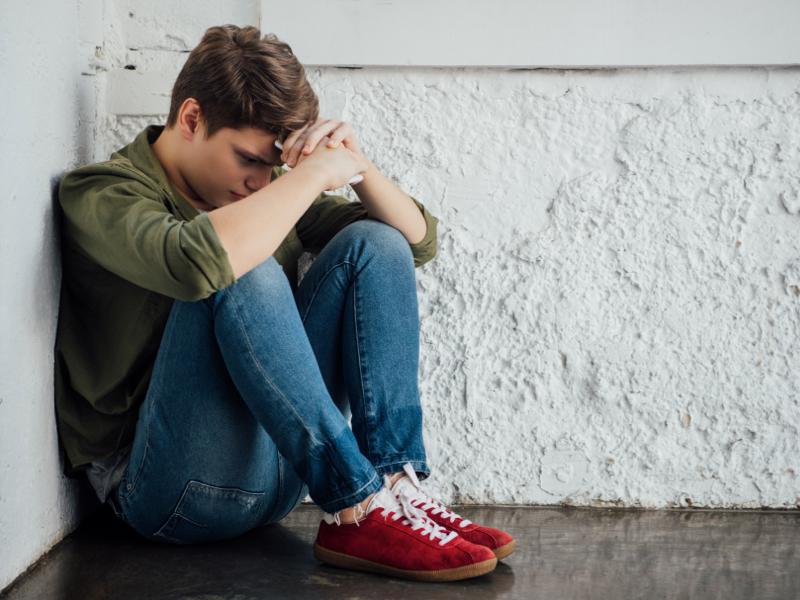
Table of Contents
Teen Mental Health Fact Sheet

Written By: Alex Bachert, MPH

Clinically Reviewed By: Dr. Jaime Ballard
October 3, 2022
5 min.
We highlight key facts about teen mental health, as well as how to prioritize your own mental wellbeing.
Learn more about our Clinical Review Process
Table of Contents
Teens and young adults are now suffering from worse mental health than previous generations. Here, we’ll share some key facts to help you understand the general state of mental health of today’s youth, where we see the greatest gaps in care, and how to seek support for you or a loved one.
- More than one in three high school students reported experiencing persistent feelings of sadness or hopelessness in 2019—a 40 percent increase from 2009. (Source)
- Approximately one in six youth reported making a suicide plan in 2019—a 44 percent increase from 2009—and suicide is now the fourth leading cause of death in adolescents ages 15-19 years across the globe. (Source)
- By 2021, nearly half of all young people in the U.S. have experienced feelings of persistent sadness or hopelessness. (Source)
- Half of all lifetime mental illness begins by age 14 and 75 percent of people are living with symptoms by age 24. (Source)
- One in five people ages 12 to 25 years reported that the pandemic has affected their mental health. (Source)
- One in ten people under age 18 experienced a mental health condition following a COVID-19 diagnosis. (Source)
The personal stories that define this greater shift in mental health prevalence largely vary by individual and their condition. There are many types of mental illness (the Diagnostic and Statistical Manual of Mental Disorders, Fifth Edition lists 300!) and each differs in signs, symptoms, and severity.
Generally speaking, however, teens who are struggling with their mental health will experience some of the following symptoms:
- Changes in eating habits
- Difficulty sleeping or sleeping too much
- Avoiding other people or activities that were once enjoyable
- Fatigue or difficulty sleeping
- Feeling hopeless or helpless
- Smoking, drinking, or using drugs more than usual or even ever before
- Extreme mood swings that interfere with relationships and responsibilities
Do you need more support with
your mental health?
Charlie Health can help.
Common mental health conditions among teens
Anxiety and depression are two of the most common categories of mental health disorders in teens.
- One in three adolescents ages 13 to 18 will experience an anxiety disorder (i.e., panic disorder, generalized anxiety, social anxiety disorder) at some point in their life, with diagnoses more common among females. (Source)
- In 2020, major depression affected nearly 17 percent of the U.S. population aged 12 to 17 years. Prevalence of major depressive episodes was higher among females (25.2 percent) than males (9.2 percent), and most common among adolescents reporting two or more races (29.9 percent). (Source)
Some of the most alarming mental health statistics, however, relate to suicide rates among teens.
- One out of six high school students across the country seriously considered suicide in the past year. (Source)
- Females are more likely than males to attempt suicide. (Source)
- Black teenagers are more likely to attempt suicide than white teenagers. (Source)
- LGBTQIA+ youth are more than four times as likely to attempt suicide than their non-LGBTQIA+ peers, and LGBTQIA+ youth suicide attempts were almost five times as likely to require medical treatment than those of non-LGBTQIA+ youth. (Source)
- 40 percent of transgender adults in the U.S. reported having made a suicide attempt and 92 percent of these individuals made their attempt before the age of 25. (Source)
- Suicide is the second leading cause of death for Native American youth age 10-24, and teen suicide rates among this group are nearly 3.5 times higher than the national average. (Source)

Access to mental healthcare for teens
Although mental health conditions are becoming more prevalent among teens across the country, many youth don’t have access to care due to a growing demand for services and limited resources.
- Each year, the U.S. spends $4.1 trillion, or more than $12,000 per person, on healthcare. (Source)
- Despite that, less than half (45 percent) of youth with a mental health diagnosis receive the treatment they need. (Source)
- Only 63 percent of U.S. counties have a facility providing mental health outpatient treatment for young people, and more than half of youth patients end up waiting two or more days in the emergency department before receiving the appropriate level of care. (Source)
- Nearly one in 13 kids in California lives with a mental health disorder that is severe enough to disrupt daily living. Unfortunately, the state has fewer than 1,300 child and adolescent psychiatrists to serve nearly 10 million youth—resulting in a major deficit of care. (Source)
Consequences of untreated mental health conditions
When left untreated, mental health conditions can have a serious effect on a teen’s short-term and long-term wellbeing.
- Poor academic performance. High school students with significant symptoms of depression are more than twice as likely to drop out of school than their peers. (Source)
- Homelessness. Mental illness has been listed as the third leading cause of homelessness for single adults, and some counts show that 20-25% of the U.S. homeless population suffer from some form of severe mental illness. (Source)
- Increased suicide risk. Suicide is the second leading cause of death for U.S. youth age 15-25, and most who attempt suicide suffer from a significant mental health disorder. (Source)
- Higher rates of substance use. Co-occurring mental illness among adolescents with substance use disorders hovers around 60-75 percent. And youth who experience a major depressive episode are twice as likely to begin using alcohol or drugs compared to youth without depression. (Source)
Get help today with Charlie Health
The facts shared today paint a grim picture of mental healthcare for teens and young adults across the country. Teens today are reporting worse mental health than ever before, but there are accessible, evidence-based resources for those seeking support (despite the national provider shortage).
Charlie Health offers virtual Intensive Outpatient Programs for adolescents, young adults, and their families. Unlike traditional online mental health programs, our high acuity care program focuses on individual talk therapy, personalized therapy groups, and family therapy to provide comprehensive mental health support for mental health disorders, substance abuse disorders, and more—all from the comfort of home. Our supportive, masters-level therapists and providers are here to listen to your needs, help you explore your treatment options, and start feeling better today.
References
https://www.cdc.gov/healthyyouth/data/yrbs/pdf/YRBSDataSummaryTrendsReport2019-508.pdf
https://www.who.int/news-room/fact-sheets/detail/adolescent-mental-health
https://www.charliehealth.com/post/generalized-anxiety-disorder-101
https://www.charliehealth.com/post/what-is-major-depressive-disorder-symptoms-causes-and-treatment
https://www.nimh.nih.gov/health/statistics/any-anxiety-disorder#part_155096
https://www.nimh.nih.gov/health/statistics/major-depression
https://www.thetrevorproject.org/resources/article/facts-about-lgbtq-youth-suicide/
https://www.aacap.org/aacap/Advocacy/Federal_and_State_Initiatives/Workforce_Maps/Home.aspx
https://pubmed.ncbi.nlm.nih.gov/29195763/
https://www.nationalhomeless.org/factsheets/Mental_Illness.pdf
https://youth.gov/youth-topics/youth-mental-health/co-occurring





